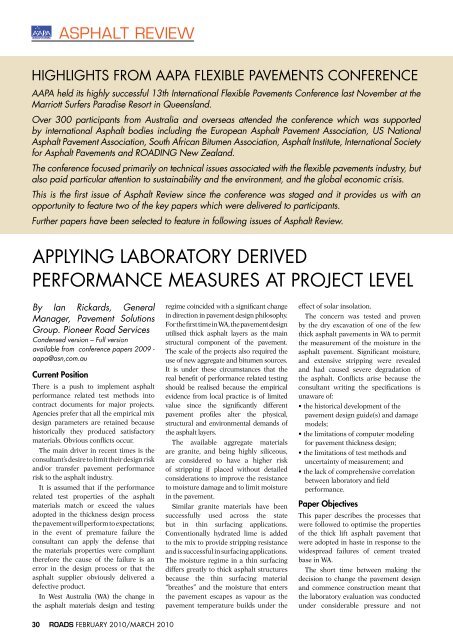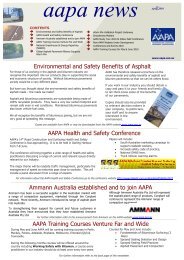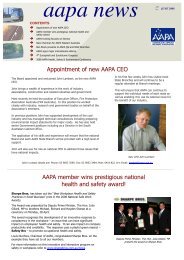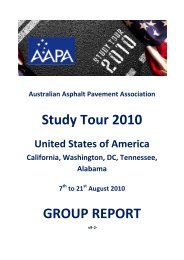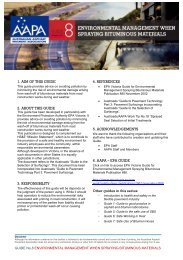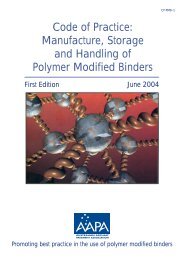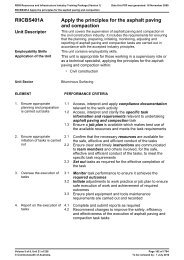Asphalt Review - Volume 29 Number 1 (February / March 2010)
Asphalt Review - Volume 29 Number 1 (February / March 2010)
Asphalt Review - Volume 29 Number 1 (February / March 2010)
- No tags were found...
You also want an ePaper? Increase the reach of your titles
YUMPU automatically turns print PDFs into web optimized ePapers that Google loves.
ASPHALT REVIEWHighlights from AAPA Flexible Pavements ConferenceAAPA held its highly successful 13th International Flexible Pavements Conference last November at theMarriott Surfers Paradise Resort in Queensland.Over 300 participants from Australia and overseas attended the conference which was supportedby international <strong>Asphalt</strong> bodies including the European <strong>Asphalt</strong> Pavement Association, US National<strong>Asphalt</strong> Pavement Association, South African Bitumen Association, <strong>Asphalt</strong> Institute, International Societyfor <strong>Asphalt</strong> Pavements and ROADING New Zealand.The conference focused primarily on technical issues associated with the flexible pavements industry, butalso paid particular attention to sustainability and the environment, and the global economic crisis.This is the first issue of <strong>Asphalt</strong> <strong>Review</strong> since the conference was staged and it provides us with anopportunity to feature two of the key papers which were delivered to participants.Further papers have been selected to feature in following issues of <strong>Asphalt</strong> <strong>Review</strong>.APPLYING LABORATORY DERIVEDPERFORMANCE MEASURES AT PROJECT LEVELBy Ian Rickards, GeneralManager, Pavement SolutionsGroup. Pioneer Road ServicesCondensed version – Full versionavailable from conference papers 2009 -aapa@asn,com.auCurrent PositionThere is a push to implement asphaltperformance related test methods intocontract documents for major projects.Agencies prefer that all the empirical mixdesign parameters are retained becausehistorically they produced satisfactorymaterials. Obvious conflicts occur.The main driver in recent times is theconsultant’s desire to limit their design riskand/or transfer pavement performancerisk to the asphalt industry.It is assumed that if the performancerelated test properties of the asphaltmaterials match or exceed the valuesadopted in the thickness design processthe pavement will perform to expectations;in the event of premature failure theconsultant can apply the defense thatthe materials properties were complianttherefore the cause of the failure is anerror in the design process or that theasphalt supplier obviously delivered adefective product.In West Australia (WA) the change inthe asphalt materials design and testingregime coincided with a significant changein direction in pavement design philosophy.For the first time in WA, the pavement designutilised thick asphalt layers as the mainstructural component of the pavement.The scale of the projects also required theuse of new aggregate and bitumen sources.It is under these circumstances that thereal benefit of performance related testingshould be realised because the empiricalevidence from local practice is of limitedvalue since the significantly differentpavement profiles alter the physical,structural and environmental demands ofthe asphalt layers.The available aggregate materialsare granite, and being highly siliceous,are considered to have a higher riskof stripping if placed without detailedconsiderations to improve the resistanceto moisture damage and to limit moisturein the pavement.Similar granite materials have beensuccessfully used across the statebut in thin surfacing applications.Conventionally hydrated lime is addedto the mix to provide stripping resistanceand is successful in surfacing applications.The moisture regime in a thin surfacingdiffers greatly to thick asphalt structuresbecause the thin surfacing material“breathes” and the moisture that entersthe pavement escapes as vapour as thepavement temperature builds under theeffect of solar insolation.The concern was tested and provenby the dry excavation of one of the fewthick asphalt pavements in WA to permitthe measurement of the moisture in theasphalt pavement. Significant moisture,and extensive stripping were revealedand had caused severe degradation ofthe asphalt. Conflicts arise because theconsultant writing the specifications isunaware of:• the historical development of thepavement design guide(s) and damagemodels;• the limitations of computer modelingfor pavement thickness design;• the limitations of test methods anduncertainty of measurement; and• the lack of comprehensive correlationbetween laboratory and fieldperformance.Paper ObjectivesThis paper describes the processes thatwere followed to optimise the propertiesof the thick lift asphalt pavement thatwere adopted in haste in response to thewidespread failures of cement treatedbase in WA.The short time between making thedecision to change the pavement designand commence construction meant thatthe laboratory evaluation was conductedunder considerable pressure and not30 ROADS FEBRUARY <strong>2010</strong>/MARCH <strong>2010</strong>


